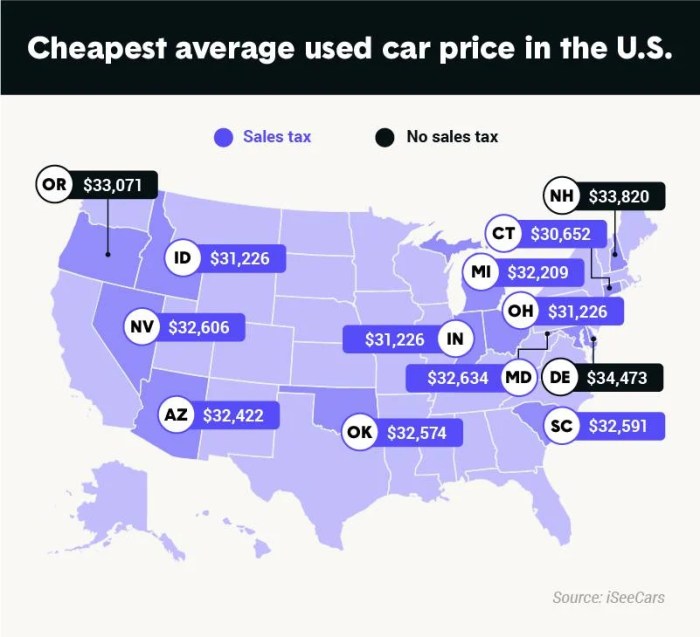Median Price of New Car in US
Median New Car Prices in the US: Median Price Of New Car In Us
Median price of new car in us – Understanding the median price of a new car in the United States is crucial for both consumers and industry analysts. This price reflects the overall health of the automotive market, influenced by economic factors, consumer preferences, and technological advancements. This article delves into the key data sources, influencing factors, historical trends, segmental comparisons, and geographical variations impacting the median price of new vehicles in the US.
The median price of a new car in the US has been steadily climbing, reflecting broader economic trends. However, luxury vehicles like the Hummer represent a significant outlier; you can explore the specifics of hummer new car price to see just how much higher these models go. This stark contrast highlights the wide range in the new car market, impacting the overall median price calculation considerably.
Data Sources for Median New Car Price

Source: thezebra.com
Several reputable sources provide data on US new car prices, each employing different methodologies and potentially exhibiting unique biases. Accurate price tracking requires understanding these nuances.
| Data Source | Methodology | Potential Biases |
|---|---|---|
| Kelley Blue Book (KBB) | Uses a combination of dealer pricing, market analysis, and consumer data to estimate values. They consider various factors such as trim level, mileage, and condition. | Potential bias towards higher-end vehicles due to greater emphasis on dealer listings and less weight on lower-end models. |
| Edmunds | Similar to KBB, Edmunds collects data from dealerships and incorporates consumer reviews and expert analysis to determine pricing. Their focus is on providing transparent pricing information. | May underrepresent prices in less populated areas due to limited data collection from dealerships in those regions. |
| JD Power | Conducts extensive surveys and analyses of consumer transactions and manufacturer data to establish pricing trends. Their reports often include detailed segmentation analysis. | Potential bias towards certain vehicle segments based on the focus of their surveys and the sampling methods used. |
Factors Influencing Median New Car Price, Median price of new car in us

Source: cloudinary.com
Numerous factors contribute to fluctuations in the median new car price. Understanding these interconnected elements provides a comprehensive view of market dynamics.
- Inflation: Rising inflation directly increases manufacturing and distribution costs, leading to higher sticker prices.
- Interest Rates: Higher interest rates make car loans more expensive, reducing affordability and potentially dampening demand, thus indirectly affecting median prices.
- Raw Material Costs: Fluctuations in the prices of steel, microchips, and other raw materials significantly impact manufacturing costs and consequently, the final price.
Other significant factors include consumer demand (influenced by economic conditions and consumer confidence), vehicle features (advanced technology and luxury features increase prices), and government regulations (fuel efficiency standards and safety regulations).
Historical Trends in Median New Car Price

Source: kbb.com
Analyzing the median new car price over the past decade reveals significant trends correlated with broader economic conditions.
| Year | Median Price (Estimate) | Economic Condition | Significant Events |
|---|---|---|---|
| 2014 | $32,000 | Steady Growth | Continued recovery from the 2008 recession |
| 2018 | $36,000 | Strong Growth | Low interest rates and high consumer confidence |
| 2022 | $48,000 | High Inflation, Supply Chain Disruptions | Microchip shortage, increased demand, and inflation |
The table above shows a general upward trend, with periods of rapid price increases correlating with economic booms and supply chain disruptions. Recessions tend to moderate price increases or even cause slight decreases.
Comparison Across Vehicle Segments
Different vehicle segments exhibit varying median prices, driven by factors such as size, features, and manufacturing costs.
A bar chart illustrating the price differences would show a clear distinction between segments like Sedans, SUVs, and Trucks. Trucks typically command the highest median price due to their size, capability, and often higher-end features. SUVs hold a middle ground, with a wider price range depending on size and features. Sedans generally have the lowest median price, although luxury sedans can command prices comparable to smaller SUVs.
Fuel efficiency standards impact median prices by influencing the design and manufacturing costs. Meeting stricter standards can increase the price of smaller, more fuel-efficient vehicles, while potentially reducing the cost advantage of larger, less efficient vehicles.
Geographic Variations in Median New Car Price
Regional variations in median new car prices exist across the US, reflecting differences in local market conditions and regulations.
A hypothetical map illustrating regional variations would show higher prices concentrated in areas with higher population density, strong economies, and higher demand (e.g., coastal regions and major metropolitan areas). Conversely, lower prices might be observed in less populated areas with lower average incomes. The map’s key would represent price ranges, using color gradients to visually represent the variations.
State-level taxes, dealer practices, and local economic conditions all contribute to these regional differences. Areas with higher sales taxes naturally increase the final price paid by consumers, while dealer pricing strategies and market competition can also influence regional variations.
FAQ Compilation
What are the typical down payments for new cars in the US?
Down payments vary widely depending on factors like the car’s price, your credit score, and the loan terms. They typically range from 10% to 20% of the vehicle’s price, but can be higher or lower in specific situations.
How do used car prices affect the median price of new cars?
Used car prices influence the new car market indirectly. High used car prices can reduce demand for new vehicles, potentially slowing price increases. Conversely, low used car prices might stimulate new car sales.
Are there any government incentives that affect new car prices?
Yes, various federal and state incentives, such as tax credits for electric or fuel-efficient vehicles, can impact the effective price of a new car for consumers, although these don’t directly change the median price itself.





















